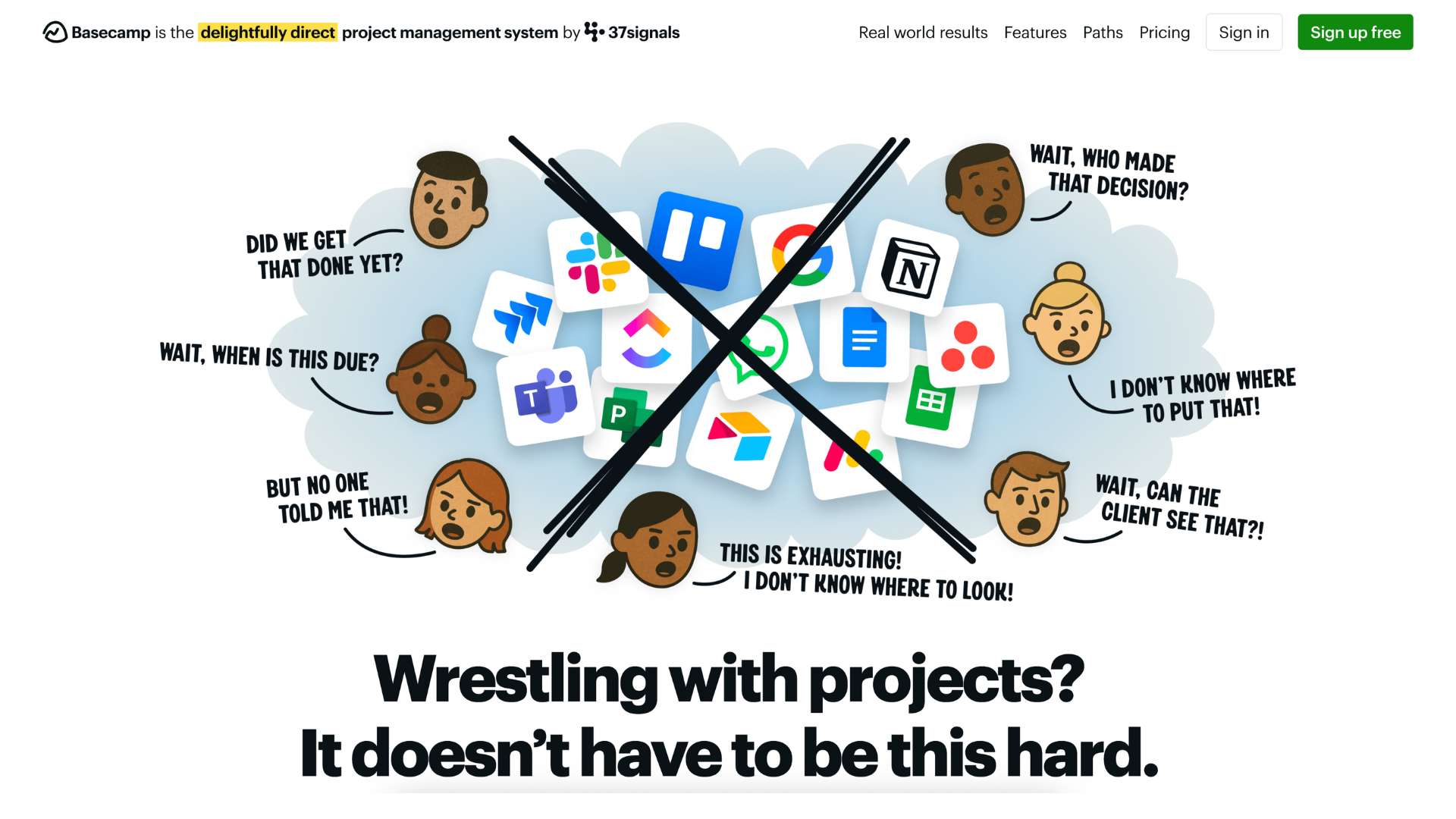Basecamp Review (2025): Features, Pricing, Pros & Cons
In an age where productivity tools are multiplying by the dozen, Basecamp continues to stand out as a pioneer in simple, unified team collaboration.
Designed to eliminate the chaos of scattered conversations, lost files, and bloated tool stacks, Basecamp offers an all-in-one space where teams can organize projects, communicate effectively, and stay on the same page.
Launched with the mission to reduce the stress of work, Basecamp’s clean design and straightforward functionality make it a favorite among startups, agencies, freelancers, and even large teams seeking clarity. It replaces the need for multiple apps like Slack, Trello, Google Drive, and email by combining task management, team chat, file storage, and scheduling into one streamlined experience.
Who is Basecamp for?
Basecamp is ideal for:
- Remote and hybrid teams needing asynchronous communication
- Agencies managing multiple clients
- Small to medium-sized businesses tired of tool overload
- Freelancers looking for client collaboration and project clarity
Company Background
- Founded: 2004 (originally as 37signals)
- Founders: Jason Fried, Carlos Segura, and Ernest Kim
- Headquarters: Chicago, Illinois, USA
- Website: https://basecamp.com
Basecamp began as an internal tool to manage web design projects. Realizing its potential, the founders pivoted toward building Basecamp into a full-fledged product, setting a new standard for project management tools.
The company is known for its strong opinions on work culture, famously expressed in the book Rework by Fried and co-founder David Heinemeier Hansson (DHH).
Key Features
Basecamp is built around simplicity and transparency. Here are its core features grouped by function:
Collaboration & Communication
| Feature | Description | Benefit |
|---|---|---|
| Campfire (Team Chat) | A real-time chat room within each project | Reduces the need for external tools like Slack |
| Message Board | Threaded discussions with formatting support | Keeps long-form discussions organized |
| @Mentions & Notifications | Tag team members and receive alerts | Improves response time and accountability |
Project & Task Management
| Feature | Description | Benefit |
|---|---|---|
| To-do Lists | Assignable tasks with due dates and comments | Simple, effective task tracking |
| Card Table (Kanban-style boards) | Visual project tracking with drag-and-drop columns | Flexible task management for Agile teams |
| Hill Charts | A unique visual progress tool | Helps identify bottlenecks and hidden risks |
Scheduling & Time Management
| Feature | Description | Benefit |
|---|---|---|
| Schedule | Built-in calendar for deadlines and events | Keeps everyone aligned on dates |
| Reminders & Check-ins | Automated status check-ins | Replaces stand-up meetings and nudges accountability |
File Sharing & Documentation
| Feature | Description | Benefit |
|---|---|---|
| Docs & Files | Upload files, images, and docs per project | Centralized storage prevents data sprawl |
| Version History | Track changes and revisions | Ensures everyone works on the latest file |
Admin & Permissions
| Feature | Description | Benefit |
|---|---|---|
| Client Access Control | Separate views for clients | Simplifies client collaboration without internal clutter |
| User Permissions | Manage access to each tool or project | Maintains privacy and structure |
User Interface and Experience (UI/UX)
Basecamp’s UI is clean, bright, and intentionally minimal. The dashboard offers a birds-eye view of all active projects and teams. Each project space is logically divided into tools like To-dos, Messages, Files, and Campfire, so users can jump straight to the function they need.
- Onboarding is extremely simple: creating your first project takes under five minutes, and built-in tutorials help new users get familiar.
- Mobile apps for iOS and Android are thoughtfully designed, with full feature parity.
- Accessibility is considered, with keyboard navigation and high-contrast modes for better usability.
Platforms Supported
| Platform | Availability |
|---|---|
| Web | Yes (fully cloud-based) |
| Windows/macOS | Via browser (no desktop app) |
| iOS | Yes (native app) |
| Android | Yes (native app) |
| Offline Access | Limited (browser-dependent caching only) |
Basecamp is cloud-native, which means there’s no need to install anything locally. However, it lacks a true offline mode, which could be a drawback for teams in low-connectivity environments.
Pricing
Basecamp’s pricing is refreshingly simple. In 2025, it offers two plans:
| Plan | Price | Includes | Best For |
|---|---|---|---|
| Basecamp | $15/user/month | All features, unlimited projects, 500GB storage | Small to medium teams |
| Basecamp Pro Unlimited | $299/month flat | Unlimited users, 5TB storage, priority support | Agencies, growing businesses, large teams |
- Free trial: 30 days, no credit card required
- Free plan: None as of 2025
Basecamp used to offer a free personal plan, but it has since been phased out to focus on professional teams.
Pros and Cons
Pros:
- Simple, distraction-free interface
No learning curve, even for non-technical users - All-in-one solution
Replaces multiple tools like Slack, Trello, Google Docs - Flat pricing for large teams
The $299/month plan is cost-effective for bigger organizations
Cons:
- No native offline mode
Requires internet access for full functionality - Limited customization
Few workflow automation or third-party add-ons - Lacks deep reporting tools
Not ideal for data-heavy or KPI-driven teams
Customer Support and Resources
- Support Channels: Email support during business hours; priority email support for Pro plan
- Help Center: Well-written articles, FAQs, and troubleshooting guides
- Live Chat or Phone: Not available
- Community: Active Basecamp community and blog with insights on productivity
- Learning Resources: Video tutorials, webinars, and guides for onboarding
While there’s no real-time support like live chat or phone, Basecamp’s resources are comprehensive and its email support is responsive.
Real-World Use Cases / Ideal Users
Ideal Users:
- Creative Agencies managing multiple clients
- Remote Teams needing structured async communication
- Startups & SMBs wanting simplicity and speed
- Freelancers who manage client projects and communication
Scenarios Where Basecamp Excels:
- A remote marketing team planning a product launch across time zones
- A digital agency coordinating with multiple clients using client-specific access
- A small startup running all projects, tasks, discussions, and files in one place without the overhead of multiple apps
User Reviews and Ratings
Here’s a snapshot of Basecamp reviews from major platforms:
| Platform | Rating | Common Praise | Common Complaint |
|---|---|---|---|
| G2 | 4.1/5 | Simple UI, all-in-one design | Lack of integrations |
| Capterra | 4.3/5 | Flat pricing, project clarity | Limited reporting |
| Trustpilot | 4.0/5 | Team alignment, ease of use | No advanced features |
User Quote (Capterra):
“Basecamp changed how we communicate. Everything’s in one place. No more email threads!” – Amanda S., Marketing Lead
Best Alternatives
If Basecamp isn’t quite what you’re looking for, here are some strong alternatives:
| Tool | Best For | Key Difference |
|---|---|---|
| Trello | Visual task management | More Kanban-focused, but fewer built-in tools |
| Asana | Structured task workflows | Offers more advanced automation |
| ClickUp | All-in-one power users | Heavier interface, more integrations |
| Monday.com | Custom workflows | Greater flexibility but more complex |
| Notion | Docs + projects | Highly customizable but less guided |
Final Verdict
Basecamp remains a standout in 2025 for teams that crave clarity over complexity. It doesn’t pretend to be everything for everyone—it simply excels at creating a unified workspace where communication, tasks, and files live together. The design ethos of “less is more” shows in every corner of the platform.
If you’re tired of juggling five different apps or managing work through email threads, Basecamp is a breath of fresh air. It’s especially valuable for smaller teams, remote groups, agencies, and freelancers who need a clear, distraction-free space to collaborate.
Explore Basecamp today with a free 30-day trial at https://basecamp.com and see how much simpler your workflow can be when everything you need is in one place.
Media
Basecamp Tutorial: How To Use Basecamp Project Management
How does Basecamp work?


